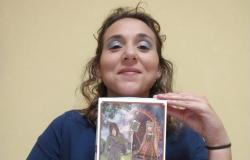“The sublime nun of art / conveys the invisible / onto the raised canvases / and with graduated gestures / and no less eloquent / than those of the prophets / portrays essential spaces / of the chromatic spectrum; / souls of color-energy / flags of creation . / His archer’s aim / fixes them on the surfaces, / wavering, cerebral lines; / harmonies of abstraction. / The transparencies reveal / and the artist illuminates them, / and sometimes darkens them / to make them invisible / to the sense profane of realism”.
It took a poet who was a friend of women like Valentino Zeichen, a diviner sensitive to the treasures of art, to describe the essence of the work of Carla Accardi (1924-2014), one of the protagonists of post-war art who for seventy years was able to innovate and transform the language of contemporary abstraction, with an original sign destined to resist time.
This is demonstrated by the magnificent retrospective curated by Daniela Lanciani and Paola Bonanni, open in Rome at the Palazzo delle Esposizioni until 9 June and strongly supported by president Marco Delogu on the centenary of the painter’s birth. Displayed in seven sumptuous rooms, around one hundred works from the Accardi Sanfilippo Archive, from the great national and international museums and from a series of private collectors, allow us to retrace the extraordinary adventure of this girl from the good bourgeoisie of Trapani, who destined nothing for the limelight of ‘art.
At just over twenty years old, Carla Accardi, small face, dazzling smile, steely will, leaves Sicily to study in Florence. From there he moved to Rome, came into contact with Gino Severini and a group of young artists who orbited in Renato Guttuso’s studio (Ugo Attardi, Piero Dorazio, Mino Guerrini, Achille Perilli, Antonio Sanfilippo, who would become her husband, and Giulio Turcato ). At the beginning of 1947, the only woman in the group, together with them she created “Forma I, Monthly of Figurative Arts”, launching in the manner of the Futurists a Manifesto for new art: “We proclaim ourselves formalists and Marxists, convinced that the terms Marxism and formalism are not irreconcilable”.
And it is a real surprise to discover, in the first room of the exhibition, a singular trait since the beginning, with the self-portrait modeled on that of Raphael, and the Still Life with cubist volumes, and the View on a tennis court, exhibited here for the first time, with the violent contrast between the red of the beaten earth, the green of the trees, the midnight blue of the sky. Then comes the abandonment of the figurative with the claim, however, of associating the decorative function with painting, but in a revolutionary way. In fact, it is urgent to valorise “the objective existence of things” and improve life, even if the reference to reality then disappears into the kaleidoscope of multicolored splinters and closed shapes that expand and retract, “… a plastic magma that always travels on the edge of change”, to quote the words of Achille Bonito Oliva. Moreover, it is Accardi herself who recognizes the continuous changing of things, with their contrasts, their miseries, their joys and conflicts, as the horizon of meaning of her work.
“My aim is to represent the vital impulse that is in the world”, he confesses to the American Hereward Lester Cooke, curator of the 1955 Roman exhibition, and to Carla Lonzi, the radical and feminist critic with whom he shares a painful militancy. Accardi’s painting, like the spatialist one, aims to express the elementary forces of the world through a sort of symbolic language of signs. This is how at the age of thirty he overcame a period of crisis, giving up the easel, and began to experiment with black and white painting, starting to trace graphic signs with paint on a canvas spread on the ground. Thus were born the Archer on white, the Labyrinth, the Siege, iconic works that earned her international fame thanks to Michel Tapié and Pierre Restany (also present with their critical writings in the magnificent anthology that accompanies the catalog printed by Quodlibet) .
But the experimentation does not stop and the new course, marked by the explosion of colour, affects signs, symbols and even materials, such as “sicofil”, the transparent acetate sold in rolls with which Carla Accardi gives way to the objective existence of things, revealing the foundation of the female condition. Here is the Tent, exhibited in 1965 in Turin and now owned by the Musée Georges Pompidou, the Triple Tent, exhibited in 1971 in Rome, and the overlapping sheets painted by inverting the colours, which mark the abandonment of the painting and the dematerialisation of the painting, to make coincide the work with a habitable space, on a human scale. “A little thing that stood straight there” Carla Lonzi will say. “An obvious thing, born from a simple idea” Accardi will say, with the aplomb of an established artist who remains humble and a woman from Trapani who doesn’t take herself seriously. A beautiful lesson in freedom, memorable not only for contemporary art.






